Mark Sisson's Blog, page 64
August 29, 2020
Garlic Balsamic Chicken with Cherry Tomatoes Recipe
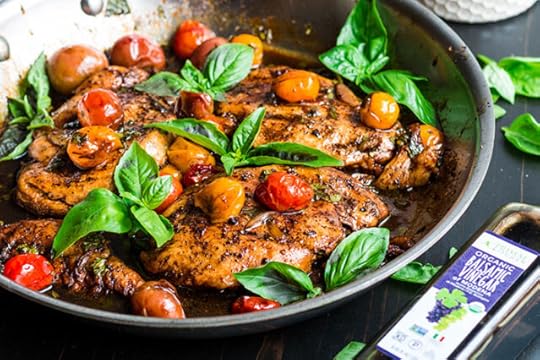 Whether you’re having friends over for dinner or you’re short on time on a weeknight, balsamic glazed chicken is a simple no-fuss meal that you can serve with virtually any side dish.
Whether you’re having friends over for dinner or you’re short on time on a weeknight, balsamic glazed chicken is a simple no-fuss meal that you can serve with virtually any side dish.
This recipe comes together in less than 15 minutes and will become your new go-to balsamic chicken recipe.
Quick tips:
Ideally, you’ll pound the chicken breasts so they’re around ?” thick. This will make sure they cook quickly but will keep them super moist and juicy once cooked.
Depending on the type of broth and coconut aminos you use, you may need to add a little additional salt at the end of cooking.
Lightly crush your garlic before slicing to release its fragrant compounds.
Let’s get started.
Garlic Balsamic Chicken Recipe
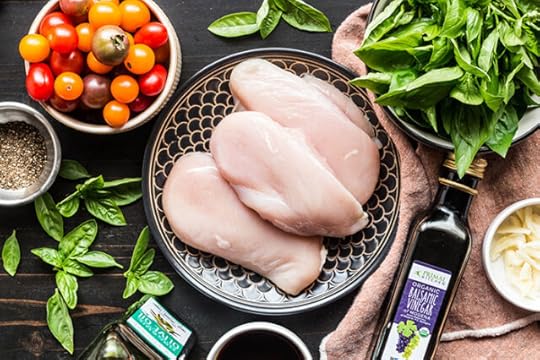 Serves: 4
Serves: 4
Time in the kitchen: 15 minutes
Ingredients
1.5 lbs. boneless chicken breasts
3 Tbsp. Primal Kitchen Olive Oil
5 clove sliced garlic
3.5 Tbsp. Primal Kitchen Balsamic Vinegar
2-3 Tbsp. chicken broth
1.5 Tbsp. coconut aminos
2 Tbsp. basil
1 cup cherry tomatoes
salt and pepper
More fresh basil
Directions
Pound the chicken breasts between two pieces of parchment using a meat mallet until they are uniform in thickness. Season both sides of the breasts liberally with salt and pepper.

Heat the olive oil in a pan over medium heat. Once hot, add the sliced garlic and stir until the garlic is fragrant. Place the chicken breasts in the pan and saute for 2 minutes on each side.
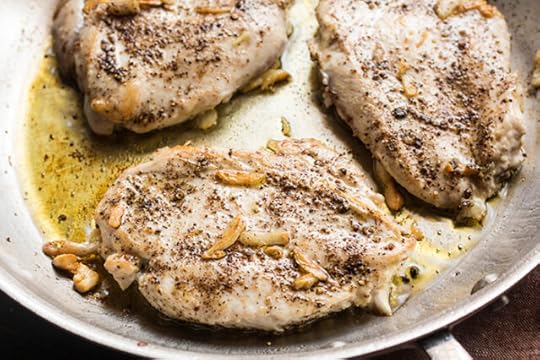 Add the balsamic vinegar and coconut aminos. Bring the mixture to a boil, then flip over the chicken again and reduce the heat to a simmer.
Add the balsamic vinegar and coconut aminos. Bring the mixture to a boil, then flip over the chicken again and reduce the heat to a simmer.
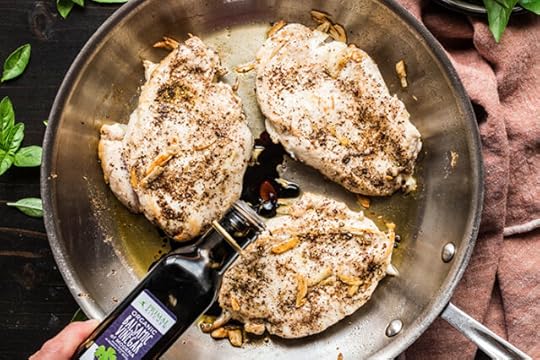
Add the broth and the tomatoes and give the pan a gentle shake. 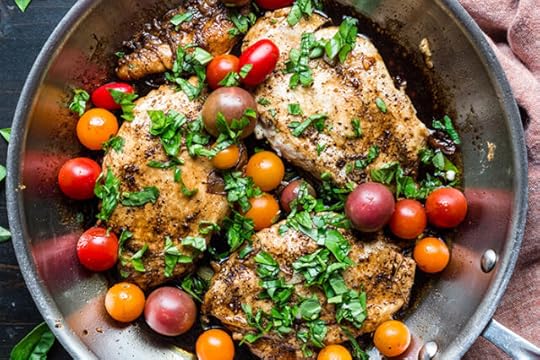 Continue cooking over medium heat over the stovetop, turning the chicken every minute or so to coat it in the balsamic mixture. Add a small amount of extra broth as needed.
Continue cooking over medium heat over the stovetop, turning the chicken every minute or so to coat it in the balsamic mixture. Add a small amount of extra broth as needed.
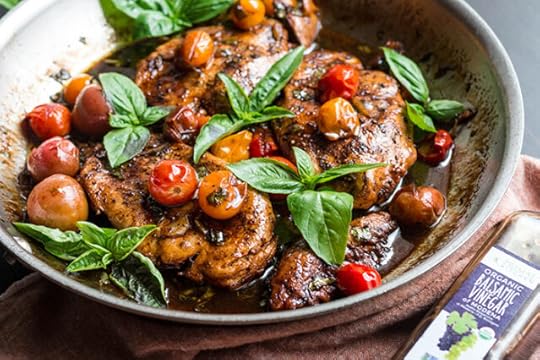
Cook until the internal temperature of the chicken reaches 165 degrees Fahrenheit and the tomatoes are soft. Garnish with fresh basil and enjoy!

Nutrition Info (serves 4):
Calories: 446
Total Fat: 13g
Total Carbs: 6g
Net Carbs: 5.3g
Protein: 50g
The post Garlic Balsamic Chicken with Cherry Tomatoes Recipe appeared first on Mark's Daily Apple.



August 28, 2020
Weekly Link Love — Edition 96

Research of the Week
Insulin exemplifies “too much of a good thing.”
Sleep-induced memory consolidation is more pronounced in kids than adults.
In older adults with obesity, a high-fat, low-carb diet burns a ton of visceral fat.
“Activating” your nuts doesn’t improve nutrient bioavailability.
New Primal Blueprint Podcasts
Episode 442: Drew Manning: Host Elle Russ welcomes Drew Manning back to the podcast to discuss his latest Fit2Fat2Forty experiment.
Media, Schmedia
Why has the Brazilian Amazon had such a good go with COVID-19?
One-night stands during a pandemic.
Interesting Blog Posts
Why are dietary guidelines still insisting we eat less saturated fat?
Are we all feeling ?
Social Notes
I prefer dogs, but I have to hand it to cats on this one.
Everything Else
COVID-19 lockdowns killed pro cyclists’ performance. Indoor training wasn’t enough.
Parents: give your kids more salmon, less poultry.
Things I’m Up to and Interested In
Chat I really enjoyed: The with Tara Garrison about metabolic flexibility and how low-carb changes everything.
Research I found interesting: New review of the interplay between selenium and COVID-19.
Cool study: Can a carnivore diet provide all essential nutrients?
Sadly I’m not surprised (though I wonder if it’s purely causal): More BPA, higher long-term mortality.
Reminder: A gluten-free diet has the potential to be lower in micronutrients if you don’t base it on whole foods.
Question I’m Asking
What’s your favorite go-to meal right now?
Recipe Corner
School lunch ideas (even though many kids aren’t going back to school yet).
Paleo bulgogi.
Time Capsule
One year ago (Aug 22 – Aug 28)
What’s TMAO, and What Does It Have to Do With My Health? – Will it kill you or won’t it?
Dear Mark: Is Fish Enough, Do Carnivores Really Need It, and More – I answer a few of your burning questions.
Comment of the Week
“I have a B.A. in Interior Design, but no one ever taught me how to design my own life; I had to discover that years later on my own. I would like to see classes in finding your life purpose, goal setting and developing good habits. In other words, classes in personal transformation.”
-Great point, Michael. Ideally, changing schools to adhere more to a child’s nature would allow this ability to develop organically.
The post Weekly Link Love — Edition 96 appeared first on Mark's Daily Apple.



August 27, 2020
Ask a Health Coach: Tuning in to What Your Body’s Telling You
 Hi folks, in this week’s Ask a Health Coach post, Erin is answering your questions about the “keto flu”, what to do when you’re hungry all the time, and how to fulfill your need for human connection during the pandemic. Keep your questions coming here in the comments or over in our Mark’s Daily Apple Facebook Group.
Hi folks, in this week’s Ask a Health Coach post, Erin is answering your questions about the “keto flu”, what to do when you’re hungry all the time, and how to fulfill your need for human connection during the pandemic. Keep your questions coming here in the comments or over in our Mark’s Daily Apple Facebook Group.
Jared asked:
“I’ve been doing Mark’s Keto Reset for a few days. At first, I felt great, but now I’m achy and all I want to do is sleep. What happened to all that energy people talk about with Keto?”
Ah yes, the keto flu. There’s no mistaking it. Well, at least to those of us who have been through it and safely made our way to the metabolically flexible side (which you will Jared, trust me). As you might have read, eating lower-carb — especially if you’re transitioning from a Standard American Diet can cause all sorts of uncomfortable symptoms. Everything from headaches and fatigue to nausea. But don’t let that keep you from sticking with it.
When you’re faced with a challenge, it’s easy to give up. And even easier to convince yourself that whatever it is you’re attempting to do isn’t right for you. So, when the going gets tough you jump ship. No shame, that’s just how it rolls sometimes.
On the flip side, a lot of people decide that punishing themselves is their only course of action. They put on a brave face and decide that they must deserve every ounce of discomfort they have coming their way. That’s the price they have to pay to “get healthy.” As crazy as it sounds, they’ve actually done studies about this. In this one, researchers asked undergraduate students to remember a time when they felt guilty, sad, or (in contrast) did something boring and non-emotionally driven like grocery shopping. Then, they gave participants six mild electrical shocks (stay with me here), with the option to increase the voltage for each subsequent shock.
The students who recalled feeling guilty, chose to raise the voltage well into the mildly painful zone, while the other groups didn’t. The use of self-punishment to reduce feelings of guilt are, unfortunately, well-documented in research.
Now, let me offer you a third perspective. What if you took this opportunity to give your body what it needed — without guilt, shame, or judgement? It may sound simple, but if you’re extra tired, why not take a midday nap or go to bed earlier? If you’re feeling achy, how about taking a few rest days or doing more gentle workouts?
Also, think about positive steps you can take to make you transition more pleasant. Most of the time the low-carb flu is caused by an electrolyte imbalance. So, drink some bone broth, eat more leafy greens, or try this homemade electrolyte drink that Mark swears by. Hang in there Jared, your symptoms won’t last long and if you can get through this preliminary phase, you’ll be home free.
Sue asked:
“As a natural extrovert, I find that I actually require human connection. Not being able to give my friends a hug might just kill me. Am I the only one who feels this way?”
First of all, you’re not alone. In addition to things like love, understanding, and growth, the desire for connection is a fundamental human need. After six months of doing what we can to slow the spread of COVID, even introverts like me are missing a good hug.
Whether it’s hugging old friends or shaking hands with new ones, most of us are used to some level of physical connection on a daily basis. And while health officials are concerned with controlling the virus (as they should be), another major issue is becoming more prevalent — and that’s the quality of our mental health due to lack of physical touch.
According to Dacher Keltner, a psychology professor at UC Berkeley, touch deprivation can impact people on a psychological and physical level. He says “positive touch activates nerves in the body that improve your immune system, regulate digestion, and helps you sleep well. It also activates parts of your brain that help you empathize.”
Researchers at Carnegie Mellon University agree, citing that hugging is proven to make people less susceptible to the virus that causes the common cold. In the study, 404 healthy adults answered questions about their perceived daily social support and how often they received hugs. Then they were intentionally exposed to the cold virus. The participants who reported having more hugs (and more social support), were less likely to get sick.
But here we are in the middle of the pandemic. And although nothing beats a loving embrace – or even a platonic one, there are some things you can do to feel more connected:
Be of service. Helping others reminds us that we’re all connected in some way. You might consider checking in on a neighbor, volunteering at a food bank, or donating to a cause you care about.
Carve out one-on-one time. Whether it’s over a video call or in-person with social distancing parameters in place, engaging one-on-one creates an emotional connection that increases levels of the feel-good hormone, oxytocin.
Take an online yoga class. Yoga studios might still be closed, but plenty offer live classes that create the feeling of being together. Watching others do the same movements and poses as you’re doing gives your brain a sense of connection, even though you’re apart.
And rest assured, we will get past this. It may be awhile, but there will be a time when we’re all hugging again like crazy.
Tracy asked:
“No matter what I try (Primal Blueprint, LCHF, intermittent fasting) I’m always starving! Aside from taping my mouth shut, what advice do you have for not shoving food in my face 24/7?”
Helping my clients achieve an effortless relationship with food is my specialty, so I’m glad I can answer this one for you. It’s different for everyone, but I find that a lot of people have become tuned out to their own hunger signals.
You might be so focused on what you can’t have that that’s all you can think about! Or maybe you were raised in the “clean plates club” where hunger had nothing to do with whether or not you took another bite.
My guess is though, that like most of today’s society, you’ve gotten so used to using food as a crutch — a way to cope with stress, boredom, sadness, happiness, or fill-in-the-blank emotion that you’ve forgotten how to listen to your own body.
Our bodies are miraculous, and they will give us the clear signs that they need fuel. That is, if you really listen. Be aware of things like:
A growling stomach
Feeling light-headed
Less energy
Less focus
Some of these signs can be subtle, especially if you’re avoiding foods like breakfast cereals, chips, cookies, and other processed foods that cause your blood sugar to spike and then crash. But there’s a great strategy you can use to determine if you’re physically hungry or just looking for something to quench your emotional hunger. To do this exercise, get in a comfortable position, close your eyes, and take a couple of slow deep breaths in and out, bringing your attention down to your stomach.
Imagine a scale from zero to ten, with zero being absolutely famished and ten being painfully full. Without judgement or deciding what number you should be, think about where on the scale describes how hungry or how full you are.
If you’re anywhere in the zero to four camp, you’re showing signs that you’re physically hungry. Five and up is an indicator that you’re not actually hungry, but instead craving something to self-soothe.
Did any of these tips resonate with you? Do you take time to listen to your body? Share your experience in the comments below.
The post Ask a Health Coach: Tuning in to What Your Body’s Telling You appeared first on Mark's Daily Apple.



August 26, 2020
How I’d Change School
 Almost no one’s happy with school these days. Kindergarteners are sitting in front of devices for 4-5 hours a day. Teens are dreading daily online meetings and getting prescriptions for “Zoom fatigue.” Some of this is growing pains—kids, teachers, and parents are being asked to completely change the way they do school on a moment’s notice, and change like that doesn’t come easily. But that’s not the only reason.
Almost no one’s happy with school these days. Kindergarteners are sitting in front of devices for 4-5 hours a day. Teens are dreading daily online meetings and getting prescriptions for “Zoom fatigue.” Some of this is growing pains—kids, teachers, and parents are being asked to completely change the way they do school on a moment’s notice, and change like that doesn’t come easily. But that’s not the only reason.
There just aren’t many great options left. Parents don’t want their kids stuck on the computer all day, nor do they want them in class masked up and unable to touch or play with their peers. There are big problems in every direction.
Change is in the air. People are fed up with the new way of doing things and realizing they don’t like the old way all that much either. I don’t have kids in school anymore, but I do have a grandkid who will be in school soon. Besides, everyone who lives in a country has a stake in the school system of that country. The schools shape the people who become the adults who shape the nation. That affects everyone. Something needs to change.
If I could wave a wand, how would I change school?
Here’s what I’d like to see:
Later start times
8:30, 9 AM. This would give kids extra sleep. Everyone needs sleep, but kids need it more than anyone. It helps them consolidate memories and recently learned skills.1 Even the CDC has called for later start times2 for schools. as kids especially need a lot of sleep. Kids are staying up later and later than ever before. Particularly in studies using teen subjects, delaying school start times by 25-60 minutes can increase total sleep duration by 25-75 minutes per weeknight.3 That’s up to more than an hour of extra sleep a night, five days a week. That’s a huge ROI.
There’s more beneficial fallout that the studies don’t address. When you push the start time back, the mornings are less stressful for everyone. Instead of giving your kid a ziploc bag full of dry cereal, you’re scrambling eggs, slicing apples, and frying bacon. You’re not worried about being late, you’re taking your time. Hell, maybe there’s even time to walk to school.
Stay on track no matter where you are! Sign up for our Primal and Keto Guide to Eating Out
Better food
Just go full whole food Primal with a macronutrient-agnostic bent:
Full-fat dairy
Real meat and eggs and seafood
Fruit and vegetables
Starchy tubers
No seed oils or gluten or refined sugar
That may sound strict. You may think “kids would never go for that.” It may be overkill. And you couldn’t control what kids ate at home or brought for lunch, and not everyone would participate in the program. But just imagine: We’d finally see what could happen if you removed most of the processed seed oil-and-sugar-and gluten-laden junk from kids’ diets—on a national scale.
A nation of kids eating eggs and fruit and kefir and potatoes cooked in butter for breakfast, a burger patty and yam for lunch with a side of full-fat milk. You’ve seen what getting some good protein, fat, and clean carbs in your kids for breakfast and lunch can do. Imagine everyone else’s kids eating the same thing. That could change the world.
Walking to school
I used to run to school every single day. That’s actually how I got into cross country running at an early age: I realized I could beat the bus to school if I just ran. So I did. Those daily runs to and from school introduced little bouts of pure freedom and adventure into my life that made me who I am today. Until several years ago, kids weren’t even allowed to show up to school alone. They needed to be dropped off or accompanied by a parent or guardian. I’d go a step further. At my ideal grade school, the default would be arriving alone. If a parent wanted to drop their kid off, they’d need a permission slip and doctor’s note.
I’m kidding, of course. But kids these days need that freedom and adventure more than ever, however they can get it. There’s not as much to go around.
More and longer recess
Recess is shrinking. Most grade school kids are lucky to get a single 20 minute block of free outdoor play per day. Some schools don’t even give first graders any recess at all, and a disturbing number of them even hold recess hostage as a punishment for poor behavior or performance.4 This is a travesty, not only because recess (and PE) increase physical activity and step count, but because physical activity improves learning and reduces acting out. In one Texas grade school, implementing four 15-minute recesses a day reduced bullying and tattling, improved focus and eye-contact, and even stopped the neurotic pencil chewing teachers were noticing among their students. The kids are testing ahead of schedule despite less actual classroom time and test prep. Recess improves academic performance, and physical play improves subsequent learning capacity. Give a kid a 15 minute play break for every 45 minutes of book learning and he’ll learn more than the kid who studies an hour straight.
Recess needs to be longer. The absolute daily minimum is 45 minutes (spread across 1-3 sessions including lunch), though I’d like to see the entire day spent outside with movement interlaced with learning/lessons.
Hold classes outdoors
The benefits are immense and irrefutable:
Kids with ADHD can focus better after exposure to green spaces.
Kids who frequently spend time outdoors get sick less often and show better motor skills and physical coordination.5
Kids with exposure (even just visual) to nature have better self-discipline.6
For kids dealing with stress at home (who isn’t?), nature can act as a buffer.7
Kids with consistent daily sun exposure have more vitamin D, better circadian rhythms, and stronger immune systems.
The more outdoor time a kid gets, the lower his or her risk of myopia.
Add to those the general benefits of green space seen in all humans and the outdoor classroom setting looks more attractive.
Ideally, the entire school day takes place outdoors, but even a small daily nature excursion is better than nothing.
Walking classrooms
We’ve all heard of Socrates’ peripatetic school, where he’d lead his students on walks around Greece while lecturing and leading discussions. This is incredible. Who else loves going on hikes with friends not just for the nature, but for the incredible conversations you end up embroiled in? There’s something special about physical movement that stimulates mental movement. Physical flow promotes cognitive blood flow.
The kids could make stops to write and do some deeper work, but class discussions and lectures could easily happen on the move.
More deep work, one subject per day
This isn’t the only way, but I think many kids and teens would thrive on a “one subject a day” schedule that allowed them to really immerse themselves in a subject or project. Imagine reading an entire book from start to finish. Imagine working on an art project all day long. Imagine getting lost in history, going down rabbit hole after rabbit hole, following whatever thread tugs on you.
Kids tend to obsess over things. Schools should take advantage of that.
Eliminate almost all rules at recess
Kids should be able to climb trees, roughhouse, leap fences, ride bikes, play tag, play dodgeball, play butts up, and all the other classic playground games that carry a modicum of danger. Kids shouldn’t be expelled for playing cops and robbers or making finger guns. Staff intervenes only if kids request it or injury is imminent. The whole point is to introduce kids to risk. Navigating relatively small risks (skinned knee, hurt feeling, short fall, wounded pride) builds mettle and prepares developing brains to deal with bigger risks. It makes them more anti-fragile. People talk about school as preparation for the meat grinder of “real life,” but most schools eliminate any real prep work because adults mediate every conflict, grievance, hogged sandbox, and stolen dinosaur toy.
Tons of climbable structures and trees
Kids (and adults) need to climb things. It’s fun, it builds strength, and introduces manageable risk and responsibility. You get stuck up in a tree, you get yourself unstuck. You can climb all the trees you want, but you’ll have to get yourself down.
I’m imagining networks of trees and structures all over the playground and campus to the point that a kid could get anywhere without touching the ground. There’s actually a great book about this: The Baron in the Trees, by Italo Calvino. It’s about a young Italian nobleman who runs away from home as a child to live in the trees surrounding his estate and stays there for the rest of his life, never touching the ground.
No busy homework
The evidence for homework is weak to nonexistent.8 Instead of giving five year olds an hour of paperwork to complete or 15 year olds four hours of work, give them open-ended suggestions.
“Read a book with your parents and tell the class about your favorite part of the story.”
“Find 7 leaves, each from a different tree, and bring them to class.”
“Start a business. Come up with a business plan, a product, and marketing materials.”
Enabling deep work and deep learning during the school day would make most “busy” homework pointless.
Bring back “tracks”
Only don’t limit these tracks to “academics.” It’s not that you split the kids up by “smart” or “dumb” or “advanced” and “behind.” You allow the kids to establish their own track based on interest and aptitude. You get more specific with the tracks.
Someone wants to just do math all day? Let them focus on that.
Someone shows promise as an artist? Let them draw and paint to their heart’s content.
Someone’s obsessed with video games? Let them learn to make their own.
Obviously, even a math-obsessed whiz kid should also read great literature, but I’m not sure the math whiz kid needs to be writing essays on “Brave New World.” Simply reading it is probably enough.
More doing and playing
Humans learn best by doing. Everyone accepts that we learn languages best by speaking it or being thrown into a foreign country, not by reading language lessons. But learning through doing works for everything. Learning the fundamentals matters, but only if you also practice them. I learned to write by reading and aping other writers. This even works in subjects like math. One American educator, Benezet, showed that children who delayed formal math instruction in favor of natural math instruction (doing) until 8th grade quickly caught up to and outperformed kids taught the traditional way.
You could very well teach simple arithmetic by playing card games like Blackjack or Addition War or Subtraction War.
You could teach (or reinforce) grammar by playing MadLibs. Or just giving kids cool things to read.
What else?
More trades
Don’t just bring back the old woodshop and metalshop. Introduce full-blown apprenticeship programs. Paid ones.
Plumbing
Masonry
Carpentry
Electrician
Agriculture
Automotive
And so on
Name a profession and you can probably figure out an apprenticeship program. Heck, this already exists in many states. Check out the listings for California apprenticeships for an idea of what’s possible. Many high schools can even set this up. I bet there are guidance counselors who currently do it, or have. But is it the norm? No. It should be.
Lots of kids would really benefit.
Teach basic competencies
There are basic physical skills everyone should learn.
Swimming
Self defense
First aid
Physical fitness (running, sprinting, climbing, strength standards)
And other “non-physical” core competencies:
Budgeting
Cooking
Cleaning
Laundry
Bill paying/taxes
Home economics, in other words.
Mixed ages
Segregation by age makes little evolutionary sense (until the public school system arose, children had historically hung out with other children of all ages). As a kid, whenever we weren’t in school I’d rove around my neighborhood in age-desegregated packs. It was all very fluid. We’d have the bigger kids leading the way, the smaller ones tagging along, and because everyone pretty much lived in the same place their whole lives, kids would graduate into different roles and new kids would always be coming up in the ranks. Without age mixing children miss out on many benefits:9
Younger kids can’t learn from older kids.
Older kids can’t learn how to teach younger kids.
Younger kids can only do age appropriate activities. With an older kid’s help, a younger child can accomplish much more. Two 4-year olds throwing a frisbee around is an exercise in futility. Include a 7-year old and it gets a whole lot more productive for everyone.
If any of this sounds good to you, what are you waiting for? No politician is going to make this happen. The Department of Education certainly won’t make these changes. You have to make it happen, either by finding a school that does this or creating your own curriculum at home. If you have the option, consider gathering together with a few other families to form a “pod” to realize your vision.
If that’s not feasible, get together with other like-minded families and petition your district for incremental change.
No one school or parent can enact all these changes. Some conflict. Some are downright impossible in certain environments. But even if you just implemented one or two of these ideas, you could have a positive impact.
What do you think, readers? Parents, kids, non-parents, teens, teachers: what does your ideal vision of early education look like?
What would you change? What you add or take away to the current set up?
Thanks for reading.
References http://www.ncbi.nlm.nih.gov/pubmed/24329882http://www.cdc.gov/features/school-start-times/http://www.ncbi.nlm.nih.gov/pubmed/26545246http://www.ncbi.nlm.nih.gov/pubmed/23834604http://link.springer.com/article/10.1023%2FA%3A1012576913074#page-1http://www.sciencedirect.com/science/article/pii/S0272494401902415http://eab.sagepub.com/content/35/3/311.abstracthttp://rer.sagepub.com/content/76/1/1.abstracthttp://www.journalofplay.org/sites/www.journalofplay.org/files/pdf-articles/3-4-article-gray-age-mixed-play.pdf
The post How I’d Change School appeared first on Mark's Daily Apple.



August 25, 2020
All About Balsamic Vinegar: Benefits & Uses
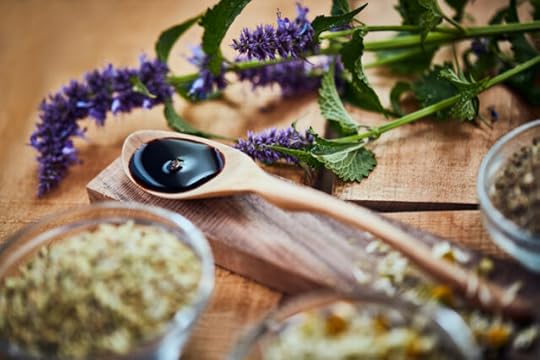 What is Balsamic Vinegar? Most likely known as the standard staple nestled in the back of your pantry reserved for the occasional tomato basil salad, balsamic vinegar is a unique piece of Italy’s history. The ancient Romans believed that cooked grape mash, or must (the main component of balsamic vinegar) was more than a dressing for foods: it was also a healing elixir. Even the name “balsamic” refers to the original medicinal purpose of this alleged restorative “balm,” indicating its place in ancient society as a tonic.
What is Balsamic Vinegar? Most likely known as the standard staple nestled in the back of your pantry reserved for the occasional tomato basil salad, balsamic vinegar is a unique piece of Italy’s history. The ancient Romans believed that cooked grape mash, or must (the main component of balsamic vinegar) was more than a dressing for foods: it was also a healing elixir. Even the name “balsamic” refers to the original medicinal purpose of this alleged restorative “balm,” indicating its place in ancient society as a tonic.
Much like champagne, the most authentic balsamic vinegar comes solely from the Reggio Emilia and Modena regions of Italy. The two areas have been perfecting the art of this dressing and condiment since the year 1100, when Balsamic Vinegar was a popular gift for visiting royalty and nobility. 1
People tend to use less of a high-quality balsamic vinegar compared to lower quality variety to achieve a similar flavor intensity.
How to Choose the Best Balsamic Vinegar
There’s no shortage of balsamic vinegar options in your neighborhood grocery store, and with a plethora of culinary uses, choosing the best balsamic vinegar is no easy task. When searching for your pick, here’s what to keep an eye out for:
PGI Certification. PGI (or, “Protected Geographic Origin”) Certification is set by the European Union to validate a product’s adherence to local heritage. To earn a PGI ( or, in Italian, IGP) certification, at least one or more steps of the preparation process must occur in the region, and the ingredients used must be closely connected to the area. A PGI Certification maintains the integrity and authenticity of the product.
Ingredient Quality. When it comes to Italian-inspired cooking, authenticity and quality of ingredients are key. Organic or Non-GMO Project Verified ingredients will let the natural flavor of the product shine through.
Area of Origin. Similar to the PGI Certification, true Balsamic Vinegar will be from or somehow connected to Modena or Emilio Reggia, Italy. 2https://www.masterclass.com/articles/what-is-balsamic-vinegar-balsamic-vs-other-vinegars-and-how-to-use-balsamic-vinegar#2-types-of-balsamic-vinegar3
Taste. Depending on the variation of vinegar you select, tastes will vary. Traditional balsamic vinegar will have a certain smoky quality, due to it’s extended aging process, while Balsamic Vinegar of Modena is more tangy and sweet.
How Is Balsamic Vinegar Made?
Traditional balsamic vinegar is made in the Emilio Reggia or Modena regions of Italy, and begins by cooking grape mash (must). It is then brought through a series of fermentations and aged in a wooden barrel. 4https://www.sciencedirect.com/science/article/pii/S10434526095800475
Aged Balsamic Vinegar
The aging process differs depending on the type of balsamic. For traditional balsamic vinegars, at least 12 years aging is required, with many being aged for over 25 years. Talk about patience! Balsamic vinegar of Modena, one of the most versatile variants, is only aged for two months. As you might expect, the aging process affects the taste and texture. 6https://www.masterclass.com/articles/what-is-balsamic-vinegar-balsamic-vs-other-vinegars-and-how-to-use-balsamic-vinegar#2-types-of-balsamic-vinegar7
Balsamic Vinegar of Modena: Why It Matters
A type of balsamic vinegar you might already be using or have seen stocked in market shelves, is Balsamic Vinegar of Modena. Balsamic Vinegar of Modena refers to not only the origin of its creation, but also the origin of the ingredients used to make it. More widely available, Balsamic Vinegar of Modena has a wide range of culinary uses. Balsamic Vinegar of Modena is slow-cooked, for a distinct flavor profile of sweet and sour, with a thicker, syrup-like consistency.
Primal Kitchen®’s recently launched Balsamic Vinegar of Modena is PGI Certified and made with Organic and Non-GMO Project Verified ingredients, for a high-quality, flavor-forward take that maintains Italian authenticity.
Balsamic Vinegar Uses
Dressing for salads
Marinade for meats
Glaze for roasted vegetables
Reduction, to bring out the sweetness and change the texture
Personalized homemade vinaigrette
How to Make Easy Homemade Balsamic Vinaigrette
Who doesn’t love a vinaigrette to dress up salads and charcuterie? A good rule of thumb to follow is a oil and vinegar dressing ratio of 3 to 1.
Here’s a basic balsamic vinaigrette recipe:
1/4 cup Primal Kitchen® balsamic vinegar
3/4 cup Primal Kitchen® extra virgin olive oil or PK avocado oil
1 tbsp Primal Kitchen® dijon
Salt and pepper to taste
From there, make it your own! Add a clove of garlic, a drizzle of honey, a pinch of herbs, a squeeze of lemon etc.
The only sure way that you know your dressing will be on point every time? Skip the mixing and use Primal Kitchen® Balsamic Vinaigrette & Marinade.
References https://www.italiaregina.it/balsamic-vinegar/[ref]
This storied history attached to balsamic vinegar makes it an exciting addition to Italian-inspired recipes and dishes, as does its versatility. From balsamic reductions, to glazes, even as a sweet and sour drizzle on vanilla ice cream, there’s no limit to the culinary uses of balsamic vinegar. Dressed up or dressed down, this condiment has serious kitchen staying power. Despite its ubiquity in most chef’s pantries, most folks don’t know the secret benefits and advantages of adding this condiment/dressing hybrid into your meal routine.
Is Balsamic Vinegar Good for You?
The Ancient Romans may have been on to something. Many cultures cite natural vinegars and vinegar products as a source for various therapeutic properties. While you won’t find doctors writing prescriptions for balsamic vinegar anytime soon, some studies show that consuming certain vinegars in their recommended amounts could have some benefits. [ref]https://pubmed.ncbi.nlm.nih.gov/27979138/[ref]
The Benefits of Balsamic Vinegar
There’s not a lot of research behind the health effects of balsamic vinegar, but the handful of studies available show that when broken down, the bioactive components found in balsamic vinegar can be linked to a myriad of benefits.
Depending on processing, some natural vinegar products may contain some combination of acetic acid, gallic acid, catechin, epicatechin, chlorogenic acid, caffeic acid, p-coumaric acid, and ferulic acid, which have been linked to having possible antimicrobial, antitumor, antiobesity, antihypertensive, and cholesterol-lowering effects. [ref]https://pubmed.ncbi.nlm.nih.gov/24811...
A study found that some fruit vinegars, again, depending on processing, could contain antioxidants. [ref]https://pubmed.ncbi.nlm.nih.gov/30934715/[ref] Antioxidants could help your body block the negative effects of oxidative stress, and research has shown their effects against cancer and aging. In addition, antioxidants may provide preventative protection against cardiovascular diseases, diabetes, obesity and other diseases. [ref]https://pubmed.ncbi.nlm.nih.gov/26633317/[ref] As far as how much antioxidant content is in your vinegar once it’s been processed, it’s hard to say.
Some fruit vinegars could contain polyphenols, [ref]https://pubmed.ncbi.nlm.nih.gov/30934715/[ref] another type of antioxidant which are thought to lower the risk of certain conditions. Some studies show that polyphenols may encourage immune system as well. [ref]https://pubmed.ncbi.nlm.nih.gov/29495598/[ref]
Balsamic Vinegar: Calories and Carbs?
Quality over quantity. When it comes to balsamic vinegar, carbs and calories tend to vary depending on processing methods, and depending on the richness of the final product. Quality of ingredients and authenticity of production are paramount when it comes to choosing a Balsamic Vinegar, especially with a serving size suggestion of just one tablespoon. Generally speaking, most balsamic vinegars range between 10-30 calories and about 7-8g of carbohydrates per serving.[ref]https://www.primalkitchen.com/collections/avocado-oil/products/organic-balsamic-vinegar-of-modena
The post All About Balsamic Vinegar: Benefits & Uses appeared first on Mark's Daily Apple.



August 24, 2020
“Don’t Jog, It’s Too Dangerous.” Evolving Your Cardio for More Benefit, Less Risk
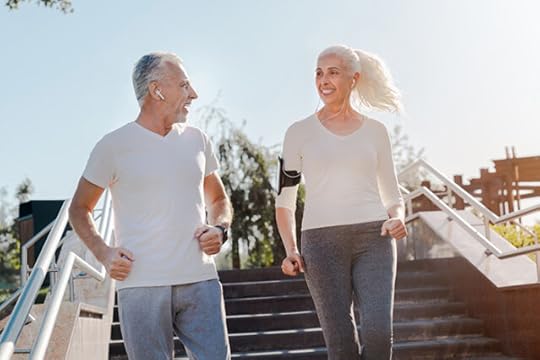 Mark’s Daily Apple veterans are familiar with one of the most controversial and impactful posts ever published to the site, Mark’s 2007 treatise called A Case Against Cardio. The article changed my life and caused me to rethink many of the flawed assumptions about endurance training that have been indoctrinated into conventional stupidity for decades. Follow up posts like this one dig deeper into the do’s and don’ts of cardiovascular exercise, as does the Primal Endurance book and online multimedia education program.
Mark’s Daily Apple veterans are familiar with one of the most controversial and impactful posts ever published to the site, Mark’s 2007 treatise called A Case Against Cardio. The article changed my life and caused me to rethink many of the flawed assumptions about endurance training that have been indoctrinated into conventional stupidity for decades. Follow up posts like this one dig deeper into the do’s and don’ts of cardiovascular exercise, as does the Primal Endurance book and online multimedia education program.
The title of this article is a quote from Paleo movement pioneer Dr. Art De Vany. Far from a tongue-in-cheek wisecrack, De Vany detailed in a 2017 podcast interview on the Tim Ferriss Show how steady state cardio is in conflict with your genetic expectations for health.
This post will provide an update on the mounting science suggesting that steady-state cardio need not, and probably should not be the centerpiece of your fitness endeavor. Plus, I’ll include suggestions to transform your routine steady state cardio workouts into fun, creative sessions that deliver broader and more impactful fitness benefits with less downside risk of drifting into chronic patterns.
Spoiler alert: I’m going to suggest you take your typical steady state jogging session at a chosen pegged heart rate and add some walking (gasp!), pace variations, and alternate activities like explosive bursts and drills that hone balance, flexibility, and mobility.
I’ve been doing steady state cardio for 40 years (gulp) as a high school and collegiate runner, pro triathlete, and Speedgolfer such that heading out the door for a morning jog at a comfortable aerobic heart rate has been programmed into habit at the same level as brushing my teeth.
High Jump as an Eye Opener
In recent months I have rekindled a longtime passion for the fabulous track field discipline of high jump. I’m trying to raise the bar in life in every way, so why not? It’s (arguably) the most beautiful and complex of track and field events because of the disparate skills and technical mastery it requires. You need speed and power for starters, but unlike Usain Bolt in the 100 meters or Carl Lewis in the long jump, high jumpers face the complexity of transferring energy from the horizontal plane (i.e., running fast) to the vertical plane (i.e., jumping high) with a difficult change of direction and different application of forces (represented by the curved approach) required to fly backward and bend the body virtually in half to clear the bar.
Consequently, I’ve been taking the opportunity of my usual ho-hum morning run to perform an assortment of creative drills and skills for high jump, and the experience has been a revelation. My outings are more fun, challenge my central nervous system to execute good technique for complex movements, and stimulate my creative energies instead of just a brain flatline outing with jogging. Actually, there’s nothing wrong with the latter in hyperconnected life, but the novel stimulation of a varied workout provides a greater sense of excitement heading out the door and a greater sense of satisfaction after the session.
Perhaps most importantly, getting off the figurative treadmill (some of you will be getting off a literal treadmill if that’s your go-to gym workout) protects you against the high-risk elements of steady state cardio. We talk about football being too violent of a sport for an evolved society (well, at least I do…), but steady state cardio is right there in the high- risk category. Enthusiasts of all ability levels engage in chronic conditions exercise patterns that lead to breakdown, burnout, illness, and injury to a shocking degree. A survey by Runners World magazine revealed that an astonishing 80 percent of the 30 million runners in America get injured in a given year—even with no tackles allowed on the marathon route!
Risks of Overtraining
More disturbing are the cardiovascular disease risk factors associated with devoted endurance training over the long run. Sisson and I keep a registry of endurance athletes (including numerous world champion caliber performers) who have suffered from serious heart problems either during, or in some cases years after retirement from elite competition. While Christopher McDougall’s book Born to Run became a bestseller, I believe the legacy of Homo sapiens as a magnificent endurance machine has been twisted out of context today. Indeed, humans evolved some incredible cardiovascular endurance advantages, such as bipedal locomotion and evaporative cooling. While this gave us an edge against other predators, evolving a complex brain was orders of magnitude more significant to rising to the top of the food chain.
It’s more anthropologically accurate to say that humans were born to move frequently at a slow pace, while possessing the ability to perform magnificent endurance feats once in a while. The amazing YouTube documentary, The Great Dance, is believed to be the first filmed account of a bonafide persistence hunt. The program follows a member of the San Bushmen tribe, modern day hunter-gatherers in Africa’s Kalahari desert, tracking an kudu antelope across the desert for four hours in 100-degree-plus temperatures. Finally, the exhausted antelope is easily caught and speared to death in place—another victory for the endurance kings of the planet! The important take away for me is that the hunter didn’t lace up his moccasins the following day to put in an easy eight-miler like a modern runner might. Life or death endurance feats (indeed, the San Bushmen clan in the flick had not feasted in quite a while due to drought) are in a different category from averaging 50-mile weeks and piling up finisher medals.
Endurance as a Once-in-a-while Endeavor
There’s nothing inherently unhealthy about pushing your limits once in a while to bag an antelope or a 50k finisher medal. It’s both physically and psychologically healthy to get out of your comfort zone now and then, counterbalance the luxuries, conveniences, and excesses of modern life, and trigger a fantastic adaptive fitness response to an extreme challenge. Mark, who finished dozens of marathons in his running career, recommends to aspiring marathoners that they complete just two marathons: The first one is to finish; the second one to improve your time! Then, check “26.2” off your bucket list with the acknowledgement that the stress of repeatedly training and competing in a footrace of that distance is going to compromise your hormonal, musculoskeletal, immune, and endocrine systems without a doubt.
After all, the marathon was introduced as an event in the first modern Olympics in 1896 in Athens to commemorate the saga of the Athenian messenger soldier Pheidippides. As legend has it, 2,500 years ago Pheidippides ran 25 miles from the battlegrounds of Marathon to Athens, burst into the Acropolis and excitedly reported, “Rejoice, we conquer!,” then promptly dropped dead on the spot. Interestingly, Greek historians now assert that the story is not true. Pheidippides is believed to have actually run from Athens to Sparta and back to Athens—a total of 300 miles over the course of four days!—to relay important battle information. It’s believed that a different messenger did the Marathon to Athens jaunt and dropped dead after delivering the news.
In any case, we can draw a clear distinction between honoring our Born to Run genetics to keep fit for life versus following the prevailing “chronic cardio” approach to endurance training that compromises health and accelerates the aging process. Like any other muscle, the heart requires an optimal balance of stress and rest to thrive. It’s unthinkable to rip your biceps to shreds doing exhaustive sets of curls day after day with insufficient rest, but we routinely treat our cardiovascular system with much less TLC than our traps and guns.
The Dangers of Excessive Cardio: Your Heart and Beyond
Dr. Peter Attia, longevity expert, host of The Drive podcast, and accomplished ultra-endurance athlete, explains what’s going on inside:
“Challenging endurance workouts cause an increase in both heart rate and stroke volume [amount of blood pumped out per beat of the heart], by stretching the heart larger to pump more blood per beat. This amazing organ can quickly go from pumping three to five liters of blood around our body per minute at rest to 30 liters per minute during very intense exercise. Unfortunately, the right side of the heart, which pumps only against the low-resistance lungs, and is far less muscular than the left ventricle, is more vulnerable to damage from chronic amounts of high cardiac output training. So while short bouts of this intensity don’t appear to cause lasting damage on the heart, prolonged activity does—at least in susceptible individuals. The so-called chronic cardio patterns can cause the right ventricle to become scarred from excessive use and insufficient recovery. This scarring can lead to cardiac arrhythmias, especially atrial fibrillation, and even sudden death in athletes who have no evidence of atherosclerosis.”
Chronic Cardio and Mitochondria
Beyond scarring and inflaming the heart, there are many other ways to contribute to your demise with chronic cardio. You can gather these under the heading of the “Extreme Exercise Hypothesis,” a concept which has recently been scientifically validated and studied with increasing urgency. Beyond blowing out your heart, Attia describes how mitochondria can become damaged by chronic exercise, a scary story of accelerated aging and health destruction to ponder: “When mitochondria are heated up too frequently for too long, proteins become denatured (destruction of the tertiary elements of the molecule, causing dysfunction) and mitochondrial DNA leaks out of cells.”
This phenomenon is highly problematic because mitochondrial DNA is perceived as a foreign agent to your body. They are different from cellular DNA and strikingly similar to bacteria cells. When mitochondrial DNA leak into the bloodstream, your immune system is confused into launching an attack against a perceived invader. This triggers an inflammatory autoimmune response (essentially the body attacking itself), a sustained pattern of which accelerates aging and disease risk. Emerging science on the gut microbiome reveals that this leaking of mitochondrial DNA into the bloodstream is particularly prevalent in the intestinal tract via a leaky gut. As you likely know from reading articles like this one on MDA, leaky gut is driven strongly by eating offensive foods like gluten and toxic seed oils, but endurance training is also a risk factor. When you elevate heart rate and raise body temperature for a prolonged workout, your gut becomes inflamed and permeable as a matter of course to respond to the workout stimulus—especially in hot temperatures. Dangers are no doubt magnified when you try to shove sugary drinks, bars, gels and blocks into said intestinal tract while blood is shunted to the extremities for performance.
“But wait, there’s more!” A 2015 Outside Magazine article titled, Running on Empty chronicled the hidden dangers of ultramarathon running, describing how numerous elite performers suddenly disappear from the face of the earth (or at least the starting line), victims of extreme burnout. A Wall Street Journal article titled, One Running Shoe In The Grave detailed how older athletes have a higher risks of health disturbances related to ambitious endurance training.
A 2015 Velo News article titled, Cycling To Extremes, explained how longtime competitive cyclists are especially vulnerable to developing atrial fibrillation because they can sit and pedal for hours on end with their heart rates pegged at a medium-to-high rate. Hence, they are unrestrained by the pounding that limits a runner’s total weekly exercise output.
Hence, other low impact sports like rowing or cross-country skiing fall into the same risk category as the cyclists. Interestingly, the weightlessness and body temperature stability with swimming lessens the strain on the cardiovascular and other body systems, providing a measure of protection to high volume swimmers.
In the book, The Great Cardio Myth, strength and conditioning expert Craig Ballantyne details how cardio exercise is ineffective for weight loss, heart disease prevention, and longevity; rather, it can have an opposite effect in each area. In cardiologist Dr. James O’Keefe’s TED Talk, “Run for your life! At a comfortable pace, and not too far,” he explains that aerobic health and disease protection are easily optimized with a couple hours of easy cardio per week, and that anything beyond that seemingly paltry total departs from the category of “health” and “longevity” and into the realm of potentially compromising health, increasing disease risk and literally accelerating cellular aging. What’s more, marketing forces brainwash serious enthusiasts to believe they aren’t really legit until they finish a marathon or triathlon. For well intentioned novices heading to the gym, they are subjected to a boot camp experience (literally!) to the extent that they associate the gym, and a fitness lifestyle, with pain and suffering.
A Better Way to Train
Alas, if you love endurance training and racing for the pursuit of peak performance, the enjoyment of nature, social connection, and the psychological satisfaction and confidence gained from pushing yourself, these huge benefits must not be discounted. It’s just a matter of rejecting the conventional stupidity of “more is better” and adopting a Primal Endurance-style holistic approach featuring healthy eating (escape carb dependency to become fat- adapted), aerobic emphasis with strict heart rate guidelines, complementary fitness activities such as flexibility/mobility exercises and brief, explosive exercises, and maintaining exceptional overall stress-rest balance in life. With a correct approach, you can preserve your health, have more fun, and still manage to perform well at endurance or ultra endurance activities.
Granted, it’s an extremely tricky balance for the Type-A subjects who populate the starting line. Sedentary observers from the peanut gallery laud the “focus and discipline” exhibited by their endurance athlete neighbor. Ironically, most of the focus and discipline required to excel in endurance sports must be directed toward restraint, stress-rest balance, and backing off when necessary.
Things are getting better as more and more enthusiasts appreciate the sensibility of a less stressful approach focused on aerobic development and minimizing the exhausting, depleting workouts (Hawaii Ironman legend Dave Scott describes them as “kinda hard”) that compromise health and increase burnout risk. It’s heartening to see the rise in popularity for the work of aerobic training pioneer Dr. Phil Maffetone, author of The Big Book of Endurance Training and Racing. Phil has been talking about the now widely accepted “180 minus age” MAF (stands for Maximum Aerobic Function; it’s also a play on Phil’s last name) nearly 40 years. He’s coached some of the greatest endurance athletes of all time, including triathlon legends Mark Allen, Mike Pigg and Tim DeBoom. Alas, Phil’s urgent message to slow down has received more lip service than strict implementation until recent years. As more and more athletes accumulate results with a sensible approach, the tide is finally turning.
In the second part of this article, we will cover ways to depart from steady state suffering to enjoy fun, challenging workouts that broaden your fitness competency without the downside risks of chronic cardio. Check back next week, and get ready to jump for joy!
The post “Don’t Jog, It’s Too Dangerous.” Evolving Your Cardio for More Benefit, Less Risk appeared first on Mark's Daily Apple.



August 22, 2020
Turn Your Grill Into a Smoker, Plus a Smoked Pork Chops Recipe
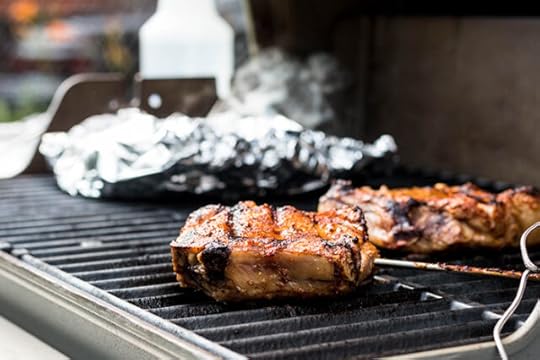 As the summer heat peaks, you probably don’t want to stand over your grill. Luckily, you can turn your grill into a smoker, creating a largely hands-off cooking process.
As the summer heat peaks, you probably don’t want to stand over your grill. Luckily, you can turn your grill into a smoker, creating a largely hands-off cooking process.
The taste of smoked meat screams summer to me, especially after spending the last eight years in North Carolina. If you want to try your hand at smoking at home but don’t have a dedicated smoker, you can actually transform your propane grill into a makeshift smoker. The process is fairly simple, but smoking time can be lengthy if you’re smoking a large cut of meat. So, a full tank of propane and some time at home are necessary to make it happen.
In this post, we’ll walk you through transforming your gas grill into a smoker and use bone-in pork chops as our test recipe.
How to Turn Your Grill Into a Smoker, and a Smoked Pork Chops Recipe
Serves: 2-4, depending on size of your pork chops
Time in the kitchen: 55 minutes, including 40 minutes hands-off smoking time
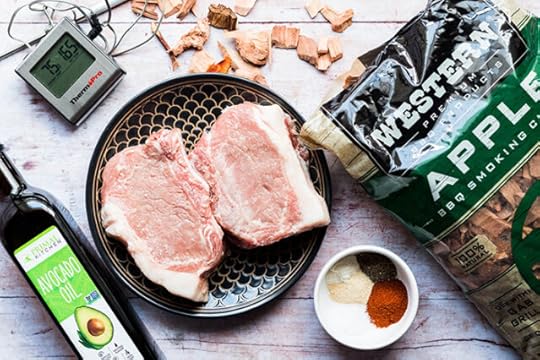
Ingredients
2 bone-in pork chops, about 1” thick
drizzle of Primal Kitchen® Avocado Oil
1 tsp. paprika
½ tsp. black pepper
½ tsp. garlic powder
½ tsp. onion powder
½ tsp. salt
optional: ¼-½ tsp. chipotle powder
3 handfuls of applewood chips
optional: your favorite Primal Kitchen® BBQ Sauce
Things to Consider when Smoking Meat
What Type of Wood Chips are Best for Smoking Meat?
Fruit tree wood: pork or chicken
Bold woods (like hickory): large cuts of pork or beef
Mesquite: beef
Pecan: all-purpose
First decide the type of wood you want to use. Fruit tree woods like apple and cherry are great for pork or chicken. More bold types of wood like hickory work well with large cuts of pork or beef. Mesquite has a distinctive flavor and best for beef. For an all-purpose wood, go with pecan which tastes great with pork, chicken and beef.
Are Wood Chunks or Chips Best for Smoking Meat?
Wood chips are much smaller than chunks and therefore burn more quickly. If you’re smoking small cuts of meat like pork chops or chicken pieces, chips work nicely. If you’re going to smoke a large brisket or pork butt, use chunks instead. I recommend using about 3 handfuls of chips for every ~40 minutes you spend smoking.
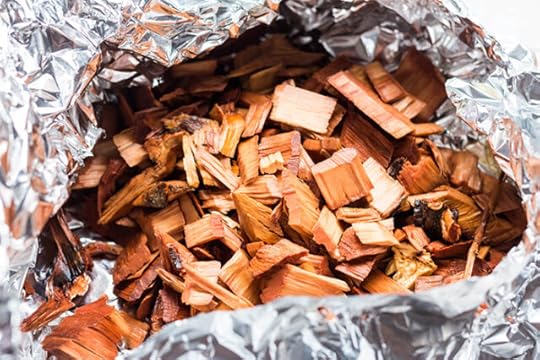
Should You Soak Wood Chips Before Smoking Meat?
Soaked wood chips take a bit longer to create nice smoke, but they will also continue smoking for a longer period of time. I recommend soaking here because it keeps the smoking environment moist and the meat is less likely to dry out. Soak wood chips for about 30 minutes.
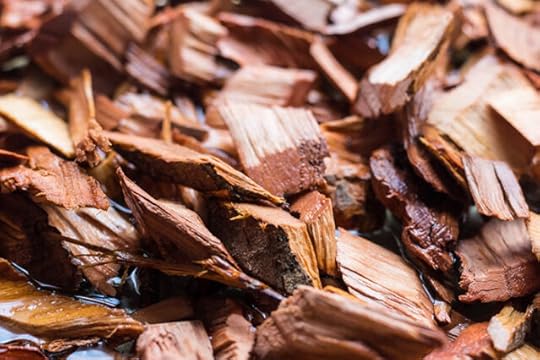
Do You Need a Smoker Box When Using Your Grill as a Smoker?
Some people buy a smoker box, or their grill comes with a smoker box, but mine does not. I kept costs down by draining the wood chips and placing them in the center of some heavy duty foil. Wrap up the wood chips in the foil and make a few holes in the foil with a knife. These holes will be where the fragrant smoke emanates from the package.

Directions
Once you have your wood chips ready, prepare your meat. Some brine their meat, but I found that a nice dry rub works well for something like bone-in pork chops or skin-on chicken thighs. Drizzle the pork chops with avocado oil and then cover the chops in the spice rub.
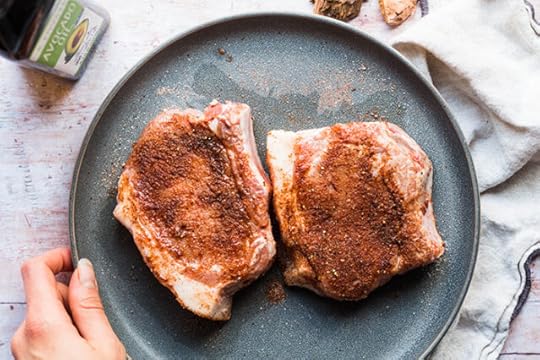
Turn your grill on and set all burners to high. Set your packet of soaked wood chips over the left or right-most burner on your grill. If your grill uses 4 heating sections, set it over 1 or 2 of the heating sections. If your grill has 3 heating zones, set the chips over the far left or far right zone.
Close your grill’s lid and let the grill heat up. It will take around 20-25 minutes for the wood chips to begin smoking. Once you see a steady amount of smoke coming from the wood packet, place your pork chops all the way to the left or right side of the grill (the side that’s opposite the wood packet). Turn off the two (or three) heat zones that aren’t heating the wood packet so that the only source of heat still on is the heating zone under the wood packet. Some say that you don’t want grill marks on smoked meat, but I can’t help but love the look of them, so I placed the chops on the right side of the grill when the grates were still a bit hot to get some marks.
Set a meat thermometer with a probe to the desired internal temperature (for pork chops, I like 145 degrees Fahrenheit) and place it through the side of the pork chop so the tip of the probe sits in the center of the chop.
 Cover the lid of the grill and let the smoking begin!
Cover the lid of the grill and let the smoking begin!
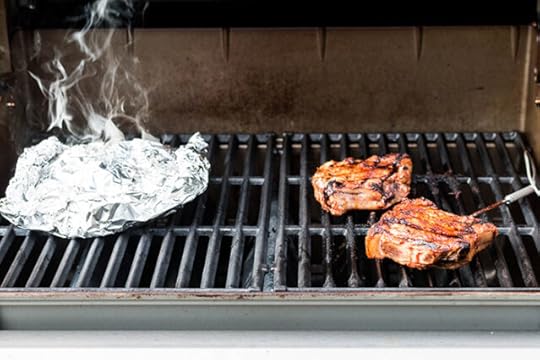
Try to avoid opening up the grill while the smoking is taking place, although after 15-20 minutes, you can flip over the chops if you choose. Continue smoking until the internal temperature is reached.
Our chops were about 1” thick and took around 40 minutes to smoke. If you are using a thicker chop or larger cut of meat, consider having a second packet of soaked wood to place on the grill after 45-60 minutes once the first packet burns out.
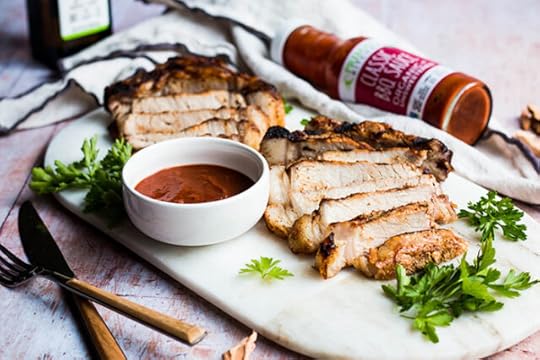
Slice into strips, and serve with your favorite Primal Kitchen® BBQ Sauce on the side. If you like sweet heat, the Mango Jalapeño BBQ Sauce will make you very happy.
Enjoy!
Nutrition facts (per 1/4 recipe)
Calories: 130
Total fat: 4.5g
Total carbs: 3g
Net carbs: 3g
Protein: 18g
The post Turn Your Grill Into a Smoker, Plus a Smoked Pork Chops Recipe appeared first on Mark's Daily Apple.



August 21, 2020
Weekly Link Love — Edition 95

Research of the Week
Intermittent fasting paired with resistance training maintains lean body mass and helps burn body fat.
IV NAC blocks inflammatory COVID-19 cascade.
Honey beats traditional cough and sore throat meds.
Breastmilk protects against coronavirus infection and replication.
Ancient hunter-gatherers likely had similar social organization as living hunter-gatherers.
New Primal Blueprint Podcasts
Episode 440: Jennifer Ludington: Host Elle Russ chats with Jennifer Ludington, a high performance mindset coach.
Episode 441: Brad Kearns Q&A: Host Brad Kearns answers your questions. Always fun.
Primal Health Coach Radio, Episode 74: Laura and Erin chat with PJ Taei about the importance of bringing content online.
Primal Health Coach Radio, Episode 75: Laura and Erin chat with Sam Miller about optimizing what you can control.
Media, Schmedia
Are all of our mental disorders actually disorders?
Growing insane produce from elephant dung.
Interesting Blog Posts
Social Notes
Everything Else
FitBits predicting COVID-19 before symptoms show.
“But high-fat low-carb only works in young fit athletes!”
Multivitamin/minerals improve immune function.
Things I’m Up to and Interested In
Term I liked: “Chrono-nutrition.”
That’s one way to do it: Scientists sequence the genes of an ancient wooly rhino whose meat they found in the stomach of an ancient dog.
Book that looks interesting: Ketones: The Fourth Fuel
Good piece on coffee: The drug that changed the world.
Horse eyes and bone hammers: These were a few of the Neanderthal’s favorite things.
Question I’m Asking
Would you work remotely forever if you could? Where would you live?
Recipe Corner
Instant Pot summer Italian chicken: a good reason to bring out the pressure cooker this season.
Chicken tagine, one of the better world dishes.
Time Capsule
One year ago (Aug 15 – Aug 21)
Recovery Workouts: Two Simple But Powerful Ways to Speed Fitness Recovery – Do these now.
The Definitive Guide to Fish: Why and How to Eat It – How to do it.
Comment of the Week
“Mark, have you ever approached a lactating woman (other than your wife) and asked for a sip from the tap? No? Than I forgive you for not realizing one of the biggest ways that adult men drinking breast milk can be unsafe, unless you’re wearing battle armor.”
–Aaron speaks from experience here, folks.
The post Weekly Link Love — Edition 95 appeared first on Mark's Daily Apple.



August 20, 2020
Ask a Health Coach: Real Tips on Breaking Through a Plateau
 Hey folks. This week, Primal Health Coach Erin is answering your questions about breaking through plateaus with tips and strategies you can start putting into practice right away. If you’re stuck in a weight loss rut, stalled out on your fitness routine, or need a push getting out of your comfort zone, today’s Ask a Health Coach post is for you. Got more questions? Keep them coming in the comments or over in our Mark’s Daily Apple Facebook Group.
Hey folks. This week, Primal Health Coach Erin is answering your questions about breaking through plateaus with tips and strategies you can start putting into practice right away. If you’re stuck in a weight loss rut, stalled out on your fitness routine, or need a push getting out of your comfort zone, today’s Ask a Health Coach post is for you. Got more questions? Keep them coming in the comments or over in our Mark’s Daily Apple Facebook Group.
Kimberley asked:
“I’ve lost a total of 70 pounds and have maintained my weight loss for over a year now, but I’m struggling to lose those last 10 pounds. Any tips on getting the scale to move again?”
First of all, congratulations. The fact that you’ve lost that amount of weight and kept if off is proof you’re committed to your goal. Even better, I love that you’re not using words like “diet” or “falling off the wagon,” both of which imply that you’ve embarked on a temporary lifestyle change. Weight loss is a long-term process that includes ups and downs. And plateaus like the one you’re experiencing right now are a natural part of that process.
Anytime you’re going through a plateau, you can take it as a sign that something needs to change. It doesn’t need to be a drastic change, but it is an opportunity to take a closer look at what you’re doing — or not doing.
I find that the biggest culprit of weight loss plateaus with my own health coaching clients is that they’ve loosened the reins a bit. In the beginning of your journey, you might have been meticulous about avoiding grains and refined sugars. If you’re following the Primal Blueprint, you might have kept your split at a solid 80/20. But as the months and years go on it’s absolutely normal to let some things slide without realizing it.
Eating more than you think is extremely common. Extra handfuls of nuts. Wine every night. A carb-fest on Sunday that turns into sandwiches and ice cream all week. You get the picture. Occasional indulgences should be enjoyed guilt-free, however it’s important to be aware of them instead of mindlessly refilling your glass. Small changes can be sneaky, and they add up fast.
Tip: Keep a Food Journal for 3-5 Days
I’m not a big fan of tracking calories and macros in general. But taking a few days to get back in touch with what you’re really doing can be a game changer for breaking through a plateau. After keeping a food journal, one of my clients found that the good stuff she was loading her morning yogurt with (chia seeds, flax seeds, unsweetened coconut, and nuts) was packing on about 400 calories more than she thought. Tasting bites of food while cooking or cleaning up are two other common places those extras tend to slide in.
Need more convincing? Researchers at Kaiser Permanente found that participants who kept a food diary lost twice the amount of weight compared to participants who didn’t.1 Writing down your choices forces you to be accountable for your actions.
It could also be that you’re restricting too much during the day, then binging at night. A food journal is a great way to monitor eating patterns and course correct right away. This free online tracker features a huge database of foods (including restaurant options), but if you’re looking for a less fussy way to keep track, just grab a notebook and start writing.
Keep this in mind too. Although the scale isn’t budging, you might actually be losing fat. Notice if your tops are easier to button, if your pants are looser, or your face is looking slimmer. People often look to the scale for validation on weight loss efforts, but what you really want is fat loss, which won’t necessarily be reflected on the scale.
Brad asked:
“I’m training for a virtual half-marathon this summer with a sub-2-hour finish goal, which would be about a 10-minute PR for me. Even though I’m running every day, I can’t seem to run faster without stopping to catch my breath. What gives?”
Just like weight loss, plateaus are an inevitable part of the training process. And while your speed may indicate what you’re capable of right now, it doesn’t dictate what you’re capable of in the future. Well, once you get to the root of what’s holding you back.
You’re putting in the work, however there could be outside forces compromising your efforts. For instance, if work or family life is really stressful or you’re not fueling yourself properly, your body will feel drained and won’t respond appropriately.
There could also be physiological factors at play. And being overly focused on your goal might be one of them. I can tell that you’re highly motivated because you’re out there training daily. But sometimes being too results-oriented can backfire.
If every time you lace up you worry that you won’t run fast enough to reach your PR, guess what will happen? You won’t run fast enough to reach your PR. Seems simple, but your mind has a powerful way of getting you closer to your goals — or further away.
The second self-doubt starts to creep in, you’re already sabotaging yourself.
In this case, training your mind is as important as training your body. Some athletes look ahead to their workouts with fear and anxiety, worrying about their performance and all the what ifsthat come with it. Others don’t let past experiences (or fears about past experiences) influence their workouts.
Stanford University psychologist, Carol Dweck studies the impact of people’s underlying beliefs about their abilities and found that those who believe their traits are fixed, meaning you’re either born with a certain trait or not (what she calls a Fixed Mindset), often resist and dread challenges, while those who believe deep down that they can improve (called a Growth Mindset) tend to reach their goals more easily.
Dweck conducted several studies and found that individuals who had a growth mindset achieved higher levels of success in different areas of their lives, regardless of their initial abilities.
Tip: Reframe your challenges as opportunities
Instead of focusing on securing your 10-minute PR, forcing faster speeds, and panicking that they won’t be fast enough, take each run as a chance to grow, without worrying about where you’ve been or where you’re going. Start by writing down your challenges. They might be, “I’m out of breath by mile 3” or “How am I going to keep this pace for 13 miles?” Then, write down the potential opportunity, like “I bet I can make it to 4 miles tomorrow” or asking yourself what you can learn about yourself from maintaining a faster-than-normal pace.
By flipping the script on your perceived obstacles, you’re actually allowing yourself to overcome them. Remember, a plateau is never permanent. And it certainly doesn’t define you as a runner. You just have to get your mind in the right space.
Jeff asked:
“I’m the official definition of a couch potato. I follow the Primal Blueprint and I’m onboard with eating meat, fish, and nuts, but when it comes to movement, it’s a no-go. I find I’m spending a lot of time sitting around, trudging through my day. How do I move the needle on starting an exercise routine?”
Our comfort zones are such a comfortable place to be, aren’t they? But here’s the deal. Comfort zones aren’t really about comfort. They’re about fear. In your case Jeff, it could be the fear of looking foolish, the fear of getting injured, or the fear of being judged. After all, if you’ve been a couch potato your whole life, what are people going to think when you start working out?
No one says you have to go all-in on a crazy exercise regimen. You don’t have to train for a marathon or even join a gym. It’s not a competition either, so what you see other people doing — even Primal Blueprint people is their business, not yours.
Tip: Start with Baby Steps
Assuming your efforts are stalling out due to the need to stay inside your comfort zone, you’ll want to brainstorm things you could do that aren’t so intense and scary. Some people thrive by jumping into the unknown, where others become quickly overwhelmed. I’m guessing you’re in the second camp.
My advice to you is to take small steps toward your goal. What would you say about walking to the end of your street and back every morning? Or following one of the quick free workouts on the Mark’s Daily Apple YouTube channel? Or adding a few microworkouts to your day that you can literally do in 60 seconds or less. You can even use your couch as a squat bench if you like.
The point is, it’s easy to get overwhelmed by activities you’ve deemed are outside of your comfort zone, but by taking baby steps, you’ll notice your comfort zone gradually getting bigger and bigger.
What’s worked for you? Tell me about your experience getting through a plateau in the comments!
References https://www.medicalnewstoday.com/articles/114298#1
The post Ask a Health Coach: Real Tips on Breaking Through a Plateau appeared first on Mark's Daily Apple.



August 19, 2020
Risk Factors for Severe COVID-19: What Makes It Harder for Some and Easier for Others?
 The way it’s reported, you’d think that susceptibility to COVID-19 severity is equally distributed across the world’s population. But when you compare case and mortality rates between countries, differences emerge. There are even differences within countries and states and cities. It’s clear that other variables besides simple exposure to the virus and infection are at play. Research continues to emerge regarding risk factors for severe COVID-19.
The way it’s reported, you’d think that susceptibility to COVID-19 severity is equally distributed across the world’s population. But when you compare case and mortality rates between countries, differences emerge. There are even differences within countries and states and cities. It’s clear that other variables besides simple exposure to the virus and infection are at play. Research continues to emerge regarding risk factors for severe COVID-19.
What are they?
And, more importantly, can you modify any of the variables?
Does Blood Type Predict COVID-19 Severity?
Early on, researchers noticed an apparent association between blood type and coronavirus infection. Those with A or B-type blood were more likely to be positive; those with type O were less likely to carry the virus.1
Although the connection between blood type and infection risk has persisted, subsequent studies have failed to find any association between infection severity and blood type.
Verdict: Doesn’t appear to apply given current evidence. However, resistance to infection does confer a kind of protection against COVID-19 severity. If you’re not infected, you can’t develop any at all, let alone severe symptoms.
Instantly download your Guide to Gut Health
Does Sex Determine Coronavirus Survival?
A meta-analysis of 12 studies performed in June 2020 found that males had a 31% higher risk of progressing to severe infection than females.2 All 12 studies analyzed had similar results; there was very little heterogeneity.
Is this caused by sex, though? After all, from what I could tell, the meta-analysis failed to control for other variables that might have differed between the groups, like metabolic syndrome or obesity. And yet sex does play a role, even when a risk factor like obesity is accounted for. Other research confirms that overweight men are at greater risk for coronavirus severity than overweight women, for example, and we know from previous research that men and women have different types of immune responses to viruses and vaccines.3
There may be a hormonal component to it, too. Estrogen therapy, for men and women, shows promise as a way to quiet inflammation (the source of coronavirus-related lung trouble) and improve survival rates.4
Verdict: Sex matters. Men are at greater risk.
Selenium Status and COVID-19
Early on, I noticed that selenium status plays a big role in susceptibility to a number of different viruses, including the flu, the original SARS, and many others. The viruses sequester selenium and utilize it to replicate and to weaken the host. Many of the original places where COVID-19 took hold had abysmal levels of soil selenium; this translates to lower levels of selenium in the food grown in the soil and a higher risk of population-wide selenium deficiency.5
Indeed, selenium status has now been implicated in COVID-19 severity. A recent study of COVID-19 patients measured the selenium statuses of those who survived and those who died. The surviving patients had much higher selenium levels.6
Verdict: Likely. This hasn’t been proven to be causal, but it’s certainly trending in that direction. It can’t hurt to eat a couple Brazil nuts every day.
Can Adequate Vitamin D Improve Coronavirus Outcomes?
The earliest coronavirus hot spots were actually colder, cloudier spots with low UV-indexes. Wuhan, China, had a ton of cloud cover in January and always has a lot of air pollution which further blocks the UV light. Lombardy, Italy, also had pollution problems and UV index too low to produce much vitamin D. And now, studies are finally coming out lending credence to the idea that vitamin D protects against severe infection.
In Iran, COVID-19 patients with vitamin D levels above 30 ng/ml had a lower risk of severe infection and death.7
In England, COVID-19 patients with higher vitamin D levels had a lower risk of hospitalization.8
It’s not just vitamin D, of course. Vitamin D is more likely a marker of sun exposure, which confers a multitude of other immune and health benefits. One such benefit with known links to COVID-19 is nitric oxide. Another is normalization of the circadian rhythm. So don’t assume mega-dosing vitamin D supplements will protect you from COVID-19 as much as getting natural sunlight will. Most of these people probably weren’t supplementing (or even thinking about) vitamin D at all. They went into the infection with the levels they had.
Verdict: Aim for 30 ng/mL and above. Get plenty of sunlight.
Does Obesity Make You More Susceptible?
Obesity is an enormous complicating variable. It’s not just because obese people are more likely to be unhealthy in other ways, although that’s probably part of it. It’s because obesity itself is unhealthy. Body fat secretes more inflammatory compounds and promotes an elevated baseline of inflammation. The coronavirus damages your body in part by up-regulating those inflammatory compounds. If you’re starting with elevated inflammation, you’re making the virus’ job that much easier.
Sure enough, obesity is linked to COVID-19 severity.9 More importantly, obesity is an independent predictor of COVID-19 severity. You can control for other variables like hypertension, diabetes, and heart disease, and the relationship persists.10 Extreme obesity (BMI of 45+) is even worse, with some research suggesting it quadruples the risk of severe COVID-19.11
Verdict: Obesity increases COVID-19 severity.
COVID-19, Diabetes, and High Blood Sugar
One recent study of 1200 Americans with COVID-19 found that those with diabetes or elevated blood sugar had a 29% mortality risk; those without diabetes or high blood sugar had just a 6% mortality risk.12 Among Chinese patients in another study, the mortality risk was 7.8% in those with diabetes and 2.7% in those without diabetes.13
Not only that, but diabetes and elevated blood sugar increases the risk of infection as well, so it’s a two-for.
Verdict: Diabetes and high blood sugar increase the risk of severe COVID-19.
Hypertension as a Risk Factor
Hypertension often rides along with obesity and diabetes, so you’d think it might be hard to disentangle it. But they’ve looked into this, and pre-existing hypertension may increase the risk of severe COVID-19 or death by 2.5-fold.14
However, those hypertension patients taking ACE inhibitors had a lower risk of severity or death than those hypertension patients who were not being treated.15 All is not lost.
Verdict: Hypertension increases the risk of severe COVID-19 outcomes, but ACE inhibitors mitigate this effect.
Previous Coronavirus Exposure
There are dozens of coronaviruses out there. The common cold stems from a type of coronavirus. The original SARS was a coronavirus, as was MERS. Animals carry coronaviruses (even our pets). And our immune systems are constantly reacting to them — even if we don’t get infected by a random coronavirus, our immune system is taking notes on and learning from it.
Perhaps that’s why T-cell immunity against other coronaviruses, like SARS, various animal coronaviruses, and perhaps even the common cold may work on COVID-19. This cross-immunity is long-lasting, too; even though SARS hit 17 years ago, many of the subjects in the study still had T-cell immunity against it.16 In another study, between 20-50% of unexposed people showed t-cell activity against COVID-19.17
Verdict: Although the details are being worked out (which coronaviruses confer some degree of immunity?) and I wouldn’t rely on this, previous coronavirus exposure seems to reduce severity.
Possible Connection to Omega-3 and Omega-6 Intake
This is speculative, but I’m confident that it will be borne out by the evidence.
Eicosanoids are inflammatory precursors—they mediate how we respond to immune insults, including inflammatory cytokines and pain responses. Eicosanoids come from the omega-3:omega=6 balance of our tissues. If we have a more omega-6-heavy tissue makeup, we will have more inflammatory eicosanoids. If we have more omega-3-heavy tissue, we will have more anti-inflammatory eicosanoids. It’s conceivable and probable that eicosanoid composition will determine COVID-19 response—and severity.18
Both dietary omega-3s and omega-6s have been shown to strongly influence tissue levels of omega-3 and omega-6 and thus inflammatory/anti-inflammatory eicosanoid balance. My guess is that seed oil-eating people with elevated tissue omega-6s are at a greater risk for severe COVID-19 than people with more balanced omega-6:omega-3 tissue levels.
Verdict: We’ll see.
Primal Blueprint Primal Omegas: a high-quality source of the two key omega-3 fatty acids, EPA and DHA
Fermented Cabbage Intake
Most of the countries with low COVID-19 mortality rates have a long tradition of eating fermented cabbage. There’s South Korea with kimchi and the Balkans and Central Europe with sauerkraut. And in a recent study, researchers found that fermented cabbage intake predicted low COVID-19 mortality.19
This is very preliminary and far from conclusive, but it makes sense. Fermented cabbage contains compounds that inhibit a vital receptor site through which the virus does much of its damage.
Verdict: Possible. Can’t hurt. Here’s an easy sauerkraut recipe if you want to cover your bases.
There are undoubtedly other factors that matter. Basic nutrient intake, the whole range of important vitamins and minerals we always discuss, yet-undiscovered genetic variants, macronutrient ratios, metabolic flexibility, gut health—all the things we know to affect other aspects of our health will probably play a role here, too.
But accounting for the factors I discussed today certainly won’t hurt and they may just help.
Thanks for reading, everyone. Take care!
References https://pubmed.ncbi.nlm.nih.gov/32511586/https://journals.lww.com/ccejournal/Fulltext/2020/06000/Gender_Difference_Is_Associated_With_Severity_of.26.aspxhttps://pubmed.ncbi.nlm.nih.gov/20417416/https://journals.library.ualberta.ca/jpps/index.php/JPPS/article/view/31069https://pubmed.ncbi.nlm.nih.gov/32342979/https://www.mdpi.com/2072-6643/12/7/2098https://papers.ssrn.com/sol3/papers.cfm?abstract_id=3616008https://www.medrxiv.org/content/10.1101/2020.06.21.20136903v2https://pubmed.ncbi.nlm.nih.gov/32462841/https://www.acpjournals.org/doi/10.7326/M20-3742#f1-M203742https://www.acpjournals.org/doi/10.7326/M20-3742#f1-M203742https://www.staradvertiser.com/2020/08/13/breaking-news/amid-covid-19-pandemic-people-with-diabetes-struggle-to-get-insulin/https://pubmed.ncbi.nlm.nih.gov/32369736/https://pubmed.ncbi.nlm.nih.gov/32231171/https://pubmed.ncbi.nlm.nih.gov/32228222/https://www.nature.com/articles/s41586-020-2550-zhttp://www.nature.com/articles/s41577-020-0389-zhttps://pubmed.ncbi.nlm.nih.gov/32650004/https://pubmed.ncbi.nlm.nih.gov/32762135/
The post Risk Factors for Severe COVID-19: What Makes It Harder for Some and Easier for Others? appeared first on Mark's Daily Apple.



Mark Sisson's Blog
- Mark Sisson's profile
- 199 followers










